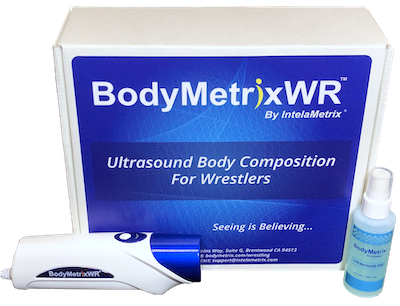ACSM
San Diego, CA
ACSM Annual Meeting
BodyMetrixWR™ System includes hand held BodyMetrix™ ultrasound probe, ultrasound gel and BodyViewWR™ software
The BodyMetrixWR™ System offers the same professional-grade ultrasound technology used by elite athletes and trainers. This high tech, cutting edge device allows you to quickly, easily and accurately make assessments. The BodyMetrixWR™System does all this without embarrassing or painful pinching. Assessments take only minutes and are not affected by hydration, exercise level or caffeine intake. Since the BodyMetrix™device can be plugged into your Windows or Mac desktop or laptop and Windows Pro tablets, you can make assessments anywhere.

Utter AC, and Hager ME. Evaluation of ultrasound in assessing body composition of high school wrestlers. Medicine and Science in Sport and Exercise, Vol. 40(5), 943-949, 2008.
Abstract:
PURPOSE: To evaluate the accuracy of ultrasound (ULTRA)
in assessing fat-free mass (FFM) in comparison to hydrostatic weighing (HW) and skinfolds (SK) in high-school (HS) wrestlers in a hydrated state.
METHODS: Body composition was determined by ULTRA, HW, and 3-site SK in 70 HS wrestlers (Mean ± SD, age: 15.5 ± 1.5, height 1.60 ± 0.08 m, body mass 65.8 ± 12.7 kg).
RESULTS: There were no significant differences for estimated FFM between ULTRA (57.2 ± 9.7 kg) and HW (57.0 ± 9.9 kg); however SK (54.9 ± 8.8 kg) were significantly different than HW. The standard errors of estimate for FFM with HW as the reference method were 2.40 kg for ULTRA and 2.74 kg for SK.
CONCLUSIONS: This study demonstrates that ULTRA provides similar estimates of FFM when compared to HW in a heterogeneous HS wrestling population during a hydrated state. ULTRA should be considered as an alternative field-based method of estimating the FFM of HS wrestlers.
Practical Applications: Results from the present investigation may be important with regard to wrestling weight certification programs established by state high-school athletic associations. The variability for ULTRA (2.31 kg) is comparable with other field-based measures of body composition in wrestlers: (1.72-1.97 kg) for SK (6,26) and lower than leg-to-leg bioelectrical impedance (BIA) (3.5 kg) (7,26). This study demonstrated that FFM values measured by the ultrasound (BodyMetrix) system were not statistically different when compared to values obtained by HW in a heterogeneous high-school wrestling population during a hydrated state, and therefore should be considered as an alternative to SK and BIA methods for determining the minimum weight for wrestlers. Ultrasound has several advantages: it does not require a high degree of technician skill and therefore is easy to use, it is safe, results are instantaneous, and the device is portable.
These advantages may make ULTA attractive to educational institutions that may not have access to trained skinfold assessors, hydrostatic weighing, air displacement plethysmography, and to address concerns that have been expressed by coaches, officials, and athletic trainers who question the results of SK testing performed by someone who may not be completely objective or impartial.
Wagner Dale, and Cotter James. Ultrasound Measurements of Subcutaneous Fat Thickness Are Robust Against Hydration Changes, Int J Sport Nutr Exerc Metab, 2021 May 1;31(3):244-249.
Abstract:
Ultrasound is an appealing tool to assess body composition, combining the portability of a field method with the accuracy of a laboratory method.
However, unlike other body composition methods, the effect of hydration status on validity is unknown. This study evaluated the impact of
acute hydration changes on ultrasound measurements of subcutaneous fat thickness and estimates of body fat percentage.
In a crossover design, 11 adults (27.1 ± 10.5 years) completed dehydration and hyperhydration trials to alter body mass by approximately ±2%.
Dehydration was achieved via humid heat (40 °C, 60% relative humidity) with exercise, whereas hyperhydration was via ingestion of lightly salted water.
Ultrasound measurements were taken at 11 body sites before and after each treatment.
Participants lost 1.56 ± 0.58 kg (-2.0 ± 0.6%) during the dehydration trial and gained 0.90 ± 0.21 kg (1.2 ± 0.2%) during the hyperhydration trial even after urination.
The sum of fat thicknesses as measured by ultrasound differed by < 0.90 mm across trials (p=.588), and ultrasound estimates of body fat percentage differed by
less than < 0.5% body fat. Ultrasound measures of subcutaneous adipose tissue were unaffected by acute
changes in hydration status by extents beyond which are rare and overtly self-correcting, suggesting that this method provides reliable and
Subcutaneous fat thickness is meaured directly using the BodyMetrix™ device at multiple anatomical sites
as shown below. Unlike calipers the BodyMetrix™ measures actual thickness and not a skinfold. This eliminates
the need to grab and pinch the skin. Using the measured values the percentage Body Fat (%BF) is automatically calculated.
The time to complete a multiple site body composition measurement is 1 -3 minutes.
BodyViewWR™ software is part of the system and provides an easy to use
interface to measure and track body composition and site fat thickness. A screen shot of the measurement page and trend page is shown below.
The BodyViewWR can generate individual measurement reports that can be printed and/or emailed.
In addition measurements can be exported to upload directly to NWCA Optimal Performance calculator.
Software is available for Windows 7-11, and Mac OS X